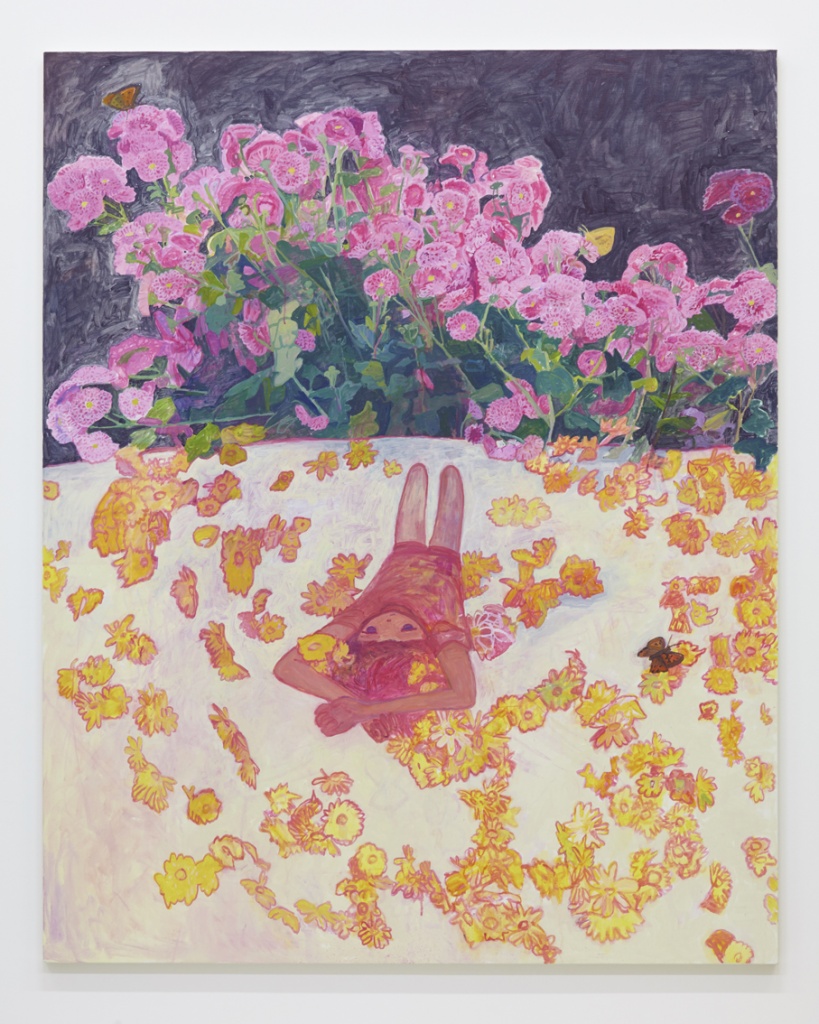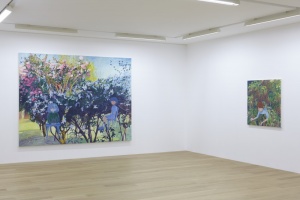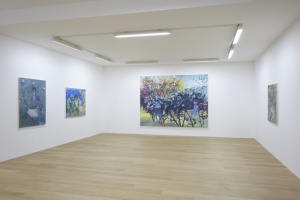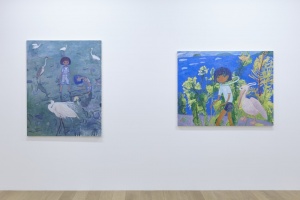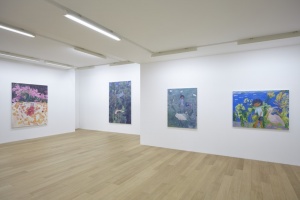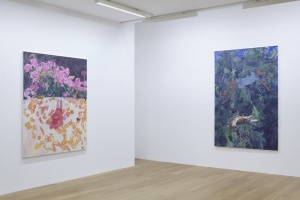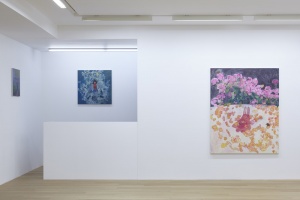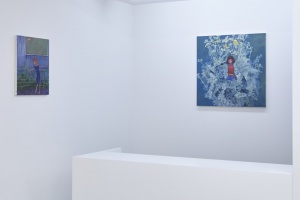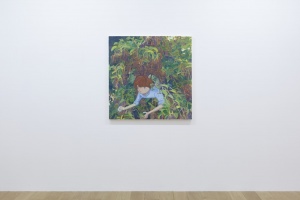Artwork Introduction
In Makiko Kudo’s paintings, a mental image-landscape unfolds within which both things she encounters in daily life and the dream-like world of her imagination that have formed a single-harmonized entity. Her audacious compositions are over-brimmed with a sense of chaotic liveliness, dynamic yet detailed brushstrokes, balanced vibrant colors, and the multiple settings and perspectives which develop simultaneously within them.
What she paints is the synthesis of things she herself has unconsciously witnessed in reality, the world she has personally experienced, and the beings around her that she shares her intimate feelings with. The flowers and plants seen during a stroll; the moon and stars of a night sky; a scene from the landscapes of her hometown; the cats of her family home, birds, young boys and girls, and so forth – seem as if released from gravity and lightly floating, precisely as if they had assimilated organically within the painting. Her stories unfold like the transient yet melancholy dream, and pursue one’s nostalgic memories. The artist Aya Takano described her first impressions on Kudo’s paintings as,”like having entered another universe.”
This floating sensation encompasses the viewers of Kudo’s works, as if they are enfolded within the world of the paintings and floated weightlessly; as if the subjects appearing within the works are, in fact, they themselves.
Further, the girly motifs in her paintings may at a glance seem contemporary, but in fact the depth created with the abstract application of paints, the compositional painting method within which several scenes and perspectives are intermingled, and the phenomena reflected in our eyes through the unadulterated physicality of its colors on the canvas, are all features that are common in classical artistic expression.
The art critic Midori Matsui has offered the following appraisal with regard to Kudo’s works:
“In Kudo’s painting, the expansion and arrangement of color areas within the pictorial space become the dominant means of communicating the picture’s emotional content. […] This attainment of emotional symbolism through the use of color fields places Kudo in the tradition of expressionistic painting exemplified by Paul Gauguin and Edvard Munch. At the same time, her almost decorative technique of making human and animal figures components of formal composition, through the arrangement, or insertion, of color fields within the pictorial space, credits Kudo as an aspiring successor of the modernist formal painting championed by Matisse”
(Matsui Midori, “The Dissolution of Color Field and Reconstruction of the World: Makiko Kudo’s Evolving Picture Plane”, in Turning, Tomio Koyama Gallery, 2012)
The curator and critic David Pagel, in the review of Makiko Kudo’s show from Los Angels Times mentioned the similarities between her work and Monet’s water lilies, Rousseau’s dreamy realism, and Matisse’s Fauvism. Pagel concluded, “Her poignant works bring intimacy and introspection to the whiplash graphics of the anime generation. The paradox of being unable to escape a place that never really felt like home is Kudo’s great subject.”
Kudo says that she paints her paintings in a light, carefree sense like drawings, usually without any touch-ups. With regard to her own painterly style, she remarks: “For myself, I prefer for there to be a mixture of areas in which the paint has been applied once, twice, three times, or not at all. I wish to preserve the beauty of the areas where the paint has been applied for only the first time.” “When the surface of painting becomes bumpy, it annoys me. More I paint over, the feeling gets worse and I really dislike that. I always want to decide at the one shot.”
The art critic Barry Schwabsky remarked on Kudo’s painting and brushwork style as followed:
“in Kudo’s painting there is a lot to know, a lot to wonder at. The multiplicity of variations in the innumerable touches by which she applies her colors is only one aspect of this. Terry R.Myers has rightly spoken of ‘a level of painterly complexity an ‘touch’ not typically seen in Japanese painting of the last decade’ in Kudo’s work, but what I want to emphasize is how this complexity of facture represents a twofold sensitivity, both to the surface of the painting as an entity that is not to be thought of as “flat” but on the contrary as dense, richly nuanced, and multivalent, and to the sensations and impulses that play across it. It is in the orchestration of this multiplicity that Kudo’s recent paintings attain a kind of classical grandeur.”
(Barry Schwabsky, “The Sum Total of Happines”, in Turning, Tomio Koyama Gallery, 2012)
Kudo’s detailed bold brushstroke creates the superb orchestra of colors and forms, and her motifs released from memories and personal experiences give an impression that weighs on the hearts of the viewers, precisely as if we ourselves are experiencing a great undulation of sensitivity with our half-forgotten childhood memories.
On the Exhibition
This exhibition succeeds to Kudo’s most recent show with Tomio Koyama Gallery in 2013, and is her sixth solo show. On “flower-patterned futon”, the work made for this exhibition she remarks, “For a long time I have wanted to paint chrysanthemums. I often forget the contents of books after I read them, but I remember only sentences that left me a strong impression. I always remembered a short novel by Osamu Dazai in which there is a lodger who paints nothing but chrysanthemum flowers – it comes to my mind every time I see a chrysanthemum flower. The futons nowadays are plain, but when I was a child my futon had Japanese-style flowers on it and I think the central part of the cover was mesh to be able to glimpse those flowers. Perhaps it was simply an association of ideas more than a motive, but that is the sort of idea behind these paintings.”
In this exhibition 18 new works will be presented.

